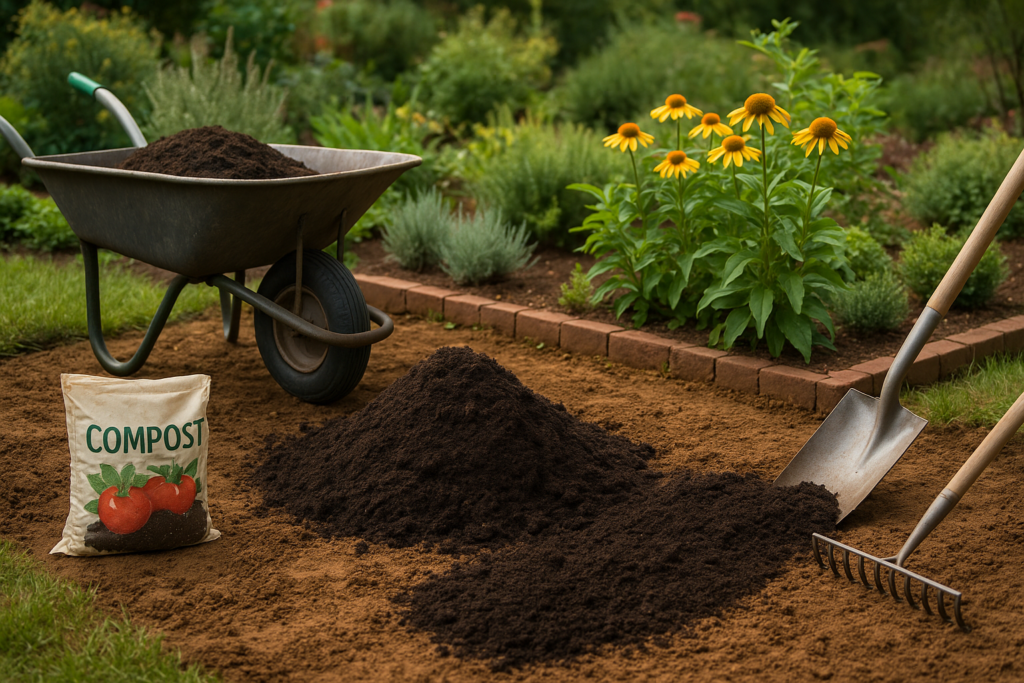Creating a thriving, sustainable outdoor space is no longer just about selecting the right plants or arranging a garden for visual appeal—it’s about cultivating healthy soil that can sustain plant life for years to come. Composting is one of the most impactful techniques that Bright View Landscape integrates into its sustainable landscaping projects. By incorporating compost into gardens, lawns, and landscaped areas, we not only nourish the soil but also reduce waste, conserve resources, and help plants flourish naturally.
In this comprehensive guide, you’ll learn how composting fits into the Bright View Landscape philosophy, the benefits it offers, and the best practices for using compost effectively in various landscaping applications.
Why Composting Is Essential in Bright View Landscape Designs
Soil Health for Long-Term Growth
Compost is decomposed organic matter rich in essential nutrients. It improves soil structure, increases its water-holding capacity, and enhances aeration. In a Bright View Landscape design, composting is a foundational step to ensure plants have the best possible start—whether for vegetable gardens, ornamental beds, or low-water landscapes.
Sustainability at Its Core
By using compost, waste materials such as yard trimmings, food scraps, and agricultural residues are recycled back into the earth. This aligns perfectly with the Bright View Landscape | Composting for Healthier, More Sustainable Gardens approach, which focuses on minimizing waste while enriching the environment.
Choosing the Right Compost for Your Landscape
Not all compost is created equal. High-quality compost should resemble dark, crumbly topsoil and smell earthy—never sour or ammonia-like. Bright View Landscape sources and uses compost that meets strict standards:
- Organic Matter: ≤30% for balanced nutrition.
- Carbon-to-Nitrogen Ratio: 30:1 or less.
- pH Level: Between 6.0 and 8.0 for plant compatibility.
Chunky compost may be fine for general landscaping, but finely screened compost is ideal for vegetable gardens and lawns.
How Bright View Landscape Integrates Composting Into Projects
1. Garden Bed Preparation
For new garden beds, apply 3–4 inches of compost and blend it into the top 8–12 inches of soil. For existing beds, an annual layer of ¼–1 inch maintains fertility without overloading the soil.
2. Raised Bed Design
Bright View Landscape advises against filling raised beds with compost alone. Instead, use a balanced mix—often a three-way or four-way soil blend—that includes compost for nutrients, topsoil for structure, and sand or other aggregates for drainage.
3. Landscape Planting Areas
Before planting, spread 3–4 inches of compost and incorporate it to a depth of 6–8 inches. This ensures root systems have immediate access to nutrient-rich soil.
For water-efficient designs, such as those in the Bright View Landscape | Low-Water Plant Design for Sustainable Beauty approach, compost helps plants retain moisture and thrive with less irrigation.
Compost in Lawn Installation and Care
New Lawns
Adding 1–2 inches of compost before seeding helps establish turf by improving soil aeration and nutrient availability. Compost mulch also prevents seeds from drying out too quickly.
Existing Lawns
Topdressing with compost improves soil health, especially when combined with aeration and overseeding. This practice strengthens turf and reduces the need for chemical fertilizers.
Avoiding Common Composting Mistakes
While compost is beneficial, too much of it can harm plants and impact water quality. Excessive soluble salts—common in mushroom or manure-based compost—can stress plants and promote algae blooms in nearby water sources. Bright View Landscape follows precise compost application rates to prevent these issues.
Compost and Low-Water Landscaping: A Perfect Match
Composting is an essential part of the Bright View Landscape Using Low-Water Plants strategy. Healthy soil enriched with compost retains water longer, reducing irrigation needs. This not only conserves water but also supports drought-tolerant plants, which are a hallmark of sustainable landscaping.
Beyond Landscaping: Sustainable Connections
Sustainable landscape design shares principles with other industries committed to precision, quality, and environmental care. Just as a Countertop Fabricator crafts surfaces with the perfect blend of function and beauty, and a stone fabricator shapes raw materials into enduring designs, composting transforms raw organic matter into a foundation for lasting growth.
Similarly, sustainable building materials such as those detailed in the Insulating Glass Unit Guide for Architects and Builders complement eco-friendly landscapes, creating holistic designs that are energy-efficient inside and out.
Step-by-Step Compost Integration for Bright View Landscape Projects
- Test the Soil: Determine pH, nutrient levels, and organic matter percentage.
- Select Compost Type: Choose based on the intended use—fine-screened for turf, coarser for perennial beds.
- Measure the Area: Calculate the compost volume needed using length × width × depth.
- Apply Correct Depth:
- New gardens: 3–4 inches.
- Existing gardens: ¼–1 inch annually.
- Lawns: 1–2 inches before seeding; ¼–½ inch for topdressing.
- Incorporate: Use hand tools or machinery for even mixing.
- Plant & Mulch: Add mulch after planting to lock in moisture and suppress weeds.
- Monitor: Adjust applications yearly based on soil test results.
The Bright View Landscape Advantage
By integrating compost into every phase of a project, Bright View Landscape ensures:
- Healthier Plants: Stronger roots, better growth, and natural resistance to pests and diseases.
- Improved Soil: Enhanced water retention, aeration, and microbial activity.
- Sustainability: Reduced waste, minimized chemical use, and improved local biodiversity.
Whether it’s a lush vegetable garden, a low-water ornamental design, or a vibrant lawn, composting is at the heart of Bright View Landscape’s sustainable landscaping solutions.
Explore more about our sustainable methods:

